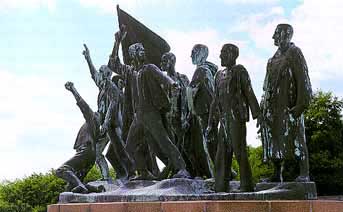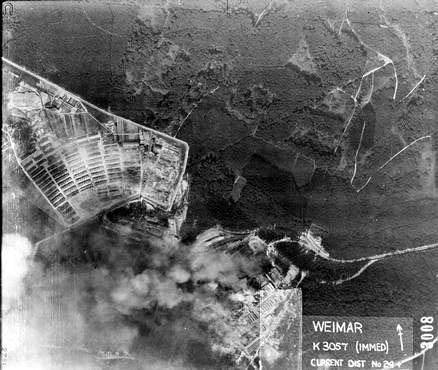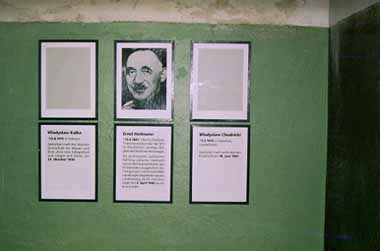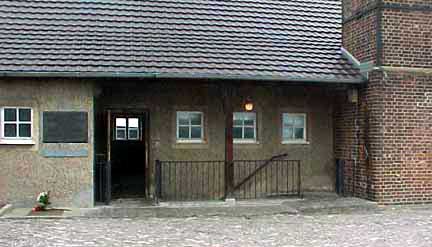Buchenwald Concentration Camp
Heroes of the Anti-Fascist Resistance

Statue in honor of
the Buchenwald resistance fighters
Buchenwald was primarily a camp for political
prisoners, who were opponents of Hitler's Third Reich. They included
prominent Communists and Social Democrats, as well as French,
Polish and Dutch resistance fighters, and also pastors of the
Confessional Church and Catholic priests who preached against
the Nazis. A Monument to the Resistance Fighters stands on the
highest point of the Ettersberg about one kilometer from the
former camp. A close-up of the statue at the monument is shown
in the photograph above.
On April 11, 1945, the day that American
troops arrived to liberate the Buchenwald camp, the Communist
resistance fighters had already taken control of the camp and
forced the SS guards to flee for their lives. When the American
liberators arrived, they observed that some of the resistance
fighters had left the camp and were hunting down the SS men in
the surrounding forest. The SS soldiers were brought back to
the camp and shot, hanged or beaten to death by the inmates while
the American soldiers looked on and sometimes joined in.
A group of barracks, called the Fichtenhain
Special Camp, was built in the forest between the SS barracks
and the military garages, outside the barbed wire enclosure of
the main camp, and reserved for VIP prisoners. These prisoners
included members of the Iron Guard, a Rumanian Fascist group
which was banned after a coup attempt against dictator Antonescu
in 1941.
One of the most famous prisoners at Buchenwald
was Leon Blum, a Jew who was the former Prime Minister of France;
he was transferred to Dachau in April 1945.
There were many French resistance fighters
in the camp; they were housed in Block 26. The French distinguished
themselves by hatching a plot to sabotage the Mibau factory at
Buchenwald where the V2 rockets were being built. The Germans
built the factory to look like a camp in hopes that the Allies
would not bomb it, but it received a direct hit in the August
24, 1944 bombing raid by the British Royal Air Force.
 Aerial map shows where
bombs hit Buchenwald
Aerial map shows where
bombs hit Buchenwald
Dr. Rudolf Breitscheid, chairman of the
Social Democrats in the German Parliament, and Mafalda, the Princess
of Hesse and daughter of the Italian king, were kept under arrest
in a separate isolation barrack, surrounded by a wall, beginning
in 1943. Both of them were killed in the bombing raid on August
24, 1944.
A total of 384 prisoners were killed
in the Ausgust 24th RAF bombing raid and around six hundred were
injured. Among the wounded were the wife and daughter of the
Camp Commandant, SS Colonel Herman Pister.
Again, on February 9, 1945, the complex
was bombed for the second time by British planes; this time,
the target was the Gustloff Works munitions factory. In this
raid 316 prisoners lost their lives out of about 2,000 employed
in the factory. Over 80 SS men were killed and 238 wounded during
this raid.
The camp prison, called the Bunker (Zellenbau),
was located in the west wing of the gatehouse, shown on the right
in the photograph below. There were two rows of cells divided
by a central hallway. The cells on the north side had windows
which looked out over the camp mustering ground (Appellplatz),
but the cells on the south side had only air holes, located on
the outside wall. The black objects on the wall in the photo
below, that look like large mail boxes, were designed with holes
in the top to let air into the cells inside. This exterior wall
of the prison wing was outside the camp. In the background you
can see the electrified barbed wire fence around the camp, and
the guard tower at the west gate.
 Prison wing of gate
house with black boxes for air holes
Prison wing of gate
house with black boxes for air holes
Cell Number One, the room closest to
the entrance of the Bunker, was where prisoners spent their last
night before being executed in the crematorium. According to
the camp records, 160 political prisoners, who were incarcerated
in the Bunker, died between 1938 and the spring of 1943. One
of them was Otto Neururer, an Austrian Catholic priest who was
executed.
Many of the prison cells have pictures
of their famous occupants. The picture below shows the cell formerly
occupied by Paul Schneider, a pastor of the Confessional Church.
This was the church co-founded by the Reverend Martin Niemöller,
who opposed the Nazis. Niemöller is famous for the following
quotation attributed to him: "First they came for the Communists,
but I was not a Communist, so I didn't speak up. Then they came
for the trade unionists, but I was not a trade unionist, so I
didn't speak up. Then they camp for the Jews, but I was not a
Jew, so I didn't speak up. Then they came for me and there was
no one left to speak for me."
 Paul Schneider's picture
hangs in his former prison cell
Paul Schneider's picture
hangs in his former prison cell
The picture below shows a display in
the cell that was occupied by Ernst Thälmann, who was the
chairman of the German Communist Party and a member of the Reichstag
(Congress or Parliament). He was allegedly executed on August
18, 1944 at the door to the Buchenwald crematorium, where there
is a plaque in his honor.
 Picture of Ernst Thälmann
in his former prison cell
Picture of Ernst Thälmann
in his former prison cell
Of all the VIP political prisoners at
the four main German camps (Dachau, Buchenwald, Mauthausen and
Sachsenhausen), Thälmann and Dr. Rudolf Breitscheid were
the only ones who died while imprisoned.
The Nazis claimed in their official party
newspaper on September 16, 1944 that both Breitscheid and Thälmann
had died in the Allied bombing raid on Buchenwald on August 24,
1944. The Buchenwald Museum guidebook admits that Breitscheid
died in the bombing raid, but not Thälmann. Breitscheid
was a prisoner in the VIP section in the Fichtenhain Special
Camp, but Thälmann was imprisoned in a cell in the Bunker
according to the display there.
According to the Buchenwald Report, Thälmann
was arrested in 1933 and was later transferred from the Bautzen
prison to Buchenwald, where he was "smuggled into the camp
by Goebbels around the time of the bombing of Buchenwald."
As anyone can see, the Bunker was not
hit in the bombing raid. To add further to the confusion, the
Museum at the former Sachsenhausen concentration camp claims
that both Breitscheid and Thälmann were executed at Sachsenhausen
in September 1944.
In the Report of a Parliamentary Delegation,
the British claimed that 750 people had been killed in the Allied
bombing raid on the factories at Buchenwald on August 24, 1944,
including 400 inmates.
The first picture below shows the crematorium
entrance where Thälmann was allegedly shot. The stairs lead
to the Leichenkeller in the basement, the place where executions
by hanging from meat hooks were allegedly carried out. To the
right, but not shown in the photo, was the chute where dead bodies
were dropped into the Leichenkeller where they were stored to
await cremation in the ovens on the floor above. The second picture
below shows a closeup of the plaque which commemorates the spot
where Thälmann was allegedly shot.
 Entrance to crematorium
and basement execution room
Entrance to crematorium
and basement execution room
 Plaque marks the spot
where Communist leader was allegedly shot
Plaque marks the spot
where Communist leader was allegedly shot
This page was last updated on November
10, 2009
|